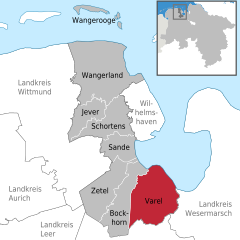|
Varel
 Varel (German pronunciation: [ˈfaːʁəl] ) is a town in the district of Friesland, in Lower Saxony, Germany. It is situated near the Jade River and the Jade Bight, approximately 15 kilometres (9.3 mi) south of Wilhelmshaven and 30 kilometres (19 mi) north of Oldenburg. With a population of 23,984 (2020) it is the biggest town in the district of Friesland. GeographyVarel is located south of the Jade Bight at the North Sea on the Geest. Over time, the city expanded into lower areas as the construction of dykes helped to secure these areas from floods. The environment of Varel is shaped by agriculture, forests and the sea. Neighbour municipalitiesJade in the district of Wesermarsch is the Eastern neighbour municipality of Varel. In the South of Varel one will find the municipalities Rastede and Wiefelstede which are part of the district of Ammerland. The municipality of Bockhorn is located in the West of Varel. Bockhorn is also part of the district of Friesland. Segmentation of the cityVarel is segmented into 21 localities. Besides the downtown area these are Altjührden, Borgstede, Büppel, Dangast, Dangastermoor, Grünenkamp, Hohelucht, Hohenberge, Jeringhave, Jethausen, Langendamm, Moorhausen, Neudorf, Neuenwege, Obenstrohe, Rallenbüschen, Rosenberg, Seghorn, Streek and Winkelsheide. Further villages in the municipality are Almsee, Bramloge, Brunne, Jethausermoor, Logemoor, Plaggenkrug, Rahling, Rotenhahn, Schwarzenberg, Tange, Vareler Schleuse and Wilkenhausen. Usage of areasA little more than three fourths of the area of Varel is agricultural land. The size of the forest – around ten percent of the total size – is remarkably high for a city at the North Sea coast.[3] Castle churchThe castle church is the oldest building in Varel. The first part of the church is believed to have been built in 1144.[4] The tower was added between 1200 and 1250, originally as twin towers, which were rebuilt in today's form first in 1651 and then in 1737. The altar, font and pulpit were carved in 1613 – 1618 by Ludwig Münstermann. The altar is nearly 10 metres (33 ft) high and is one of the main works of Northern German Mannerism. Before the Protestant Reformation, the patron saint was Saint Peter. Today, the castle church is a Lutheran church, with no patron saint. The church was formerly one of the buildings of the castle, which was demolished in the 19th century soon after a fire destroyed most parts of it. Notable people
Sport
International relationsVarel is twinned with: See alsoReferences
External linksWikimedia Commons has media related to Varel. Wikivoyage has a travel guide for Varel.
|
||||||||||||||||||||||||||||||||||||||||||||||||||||






